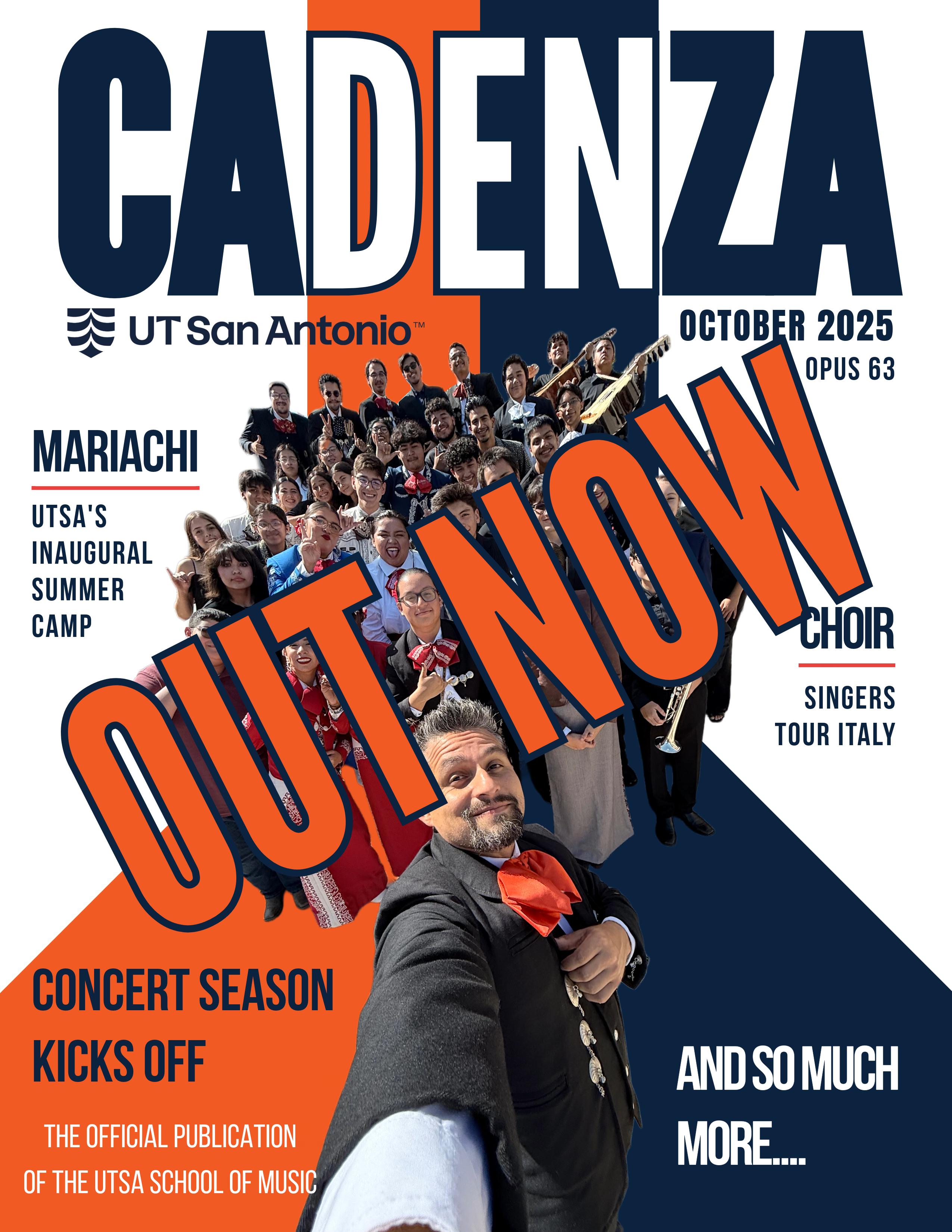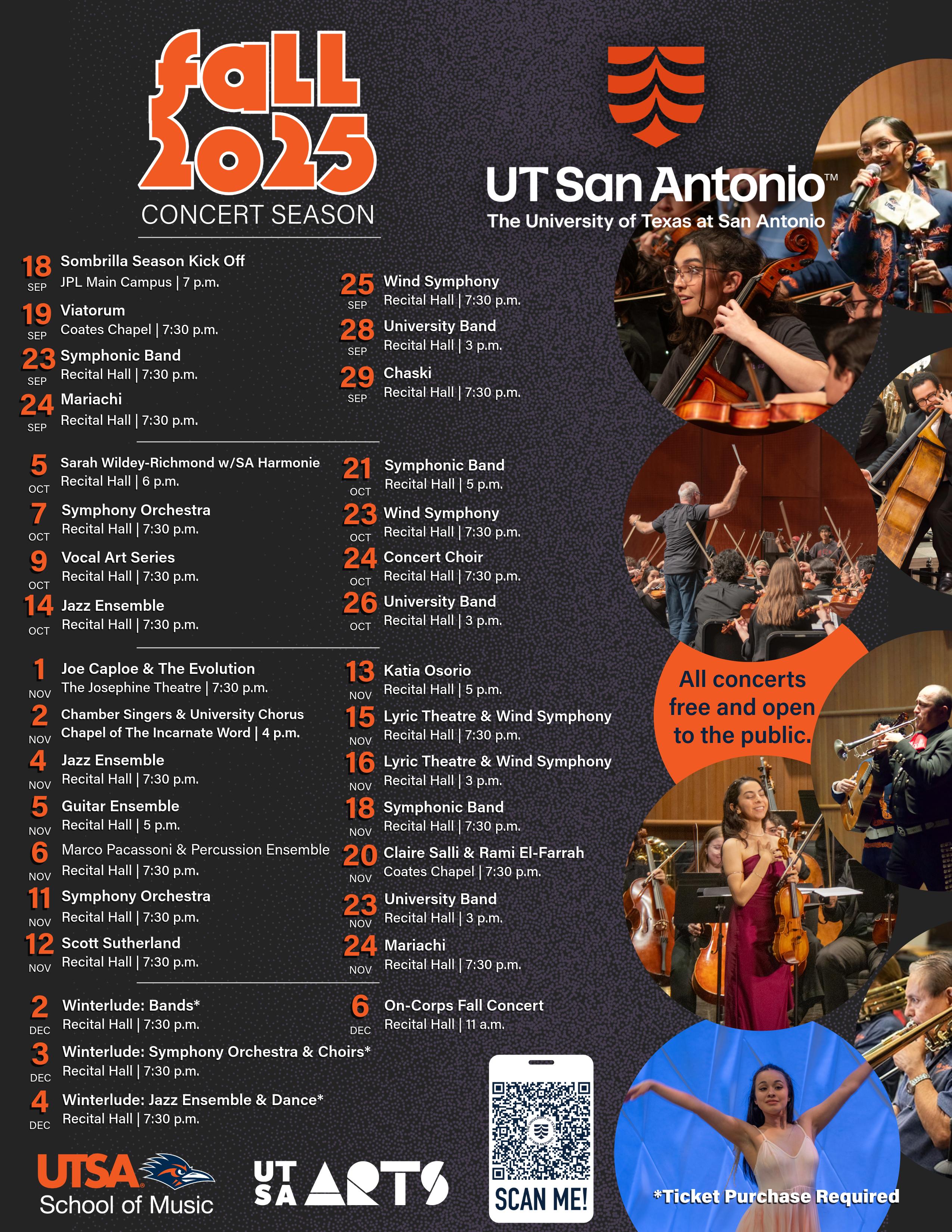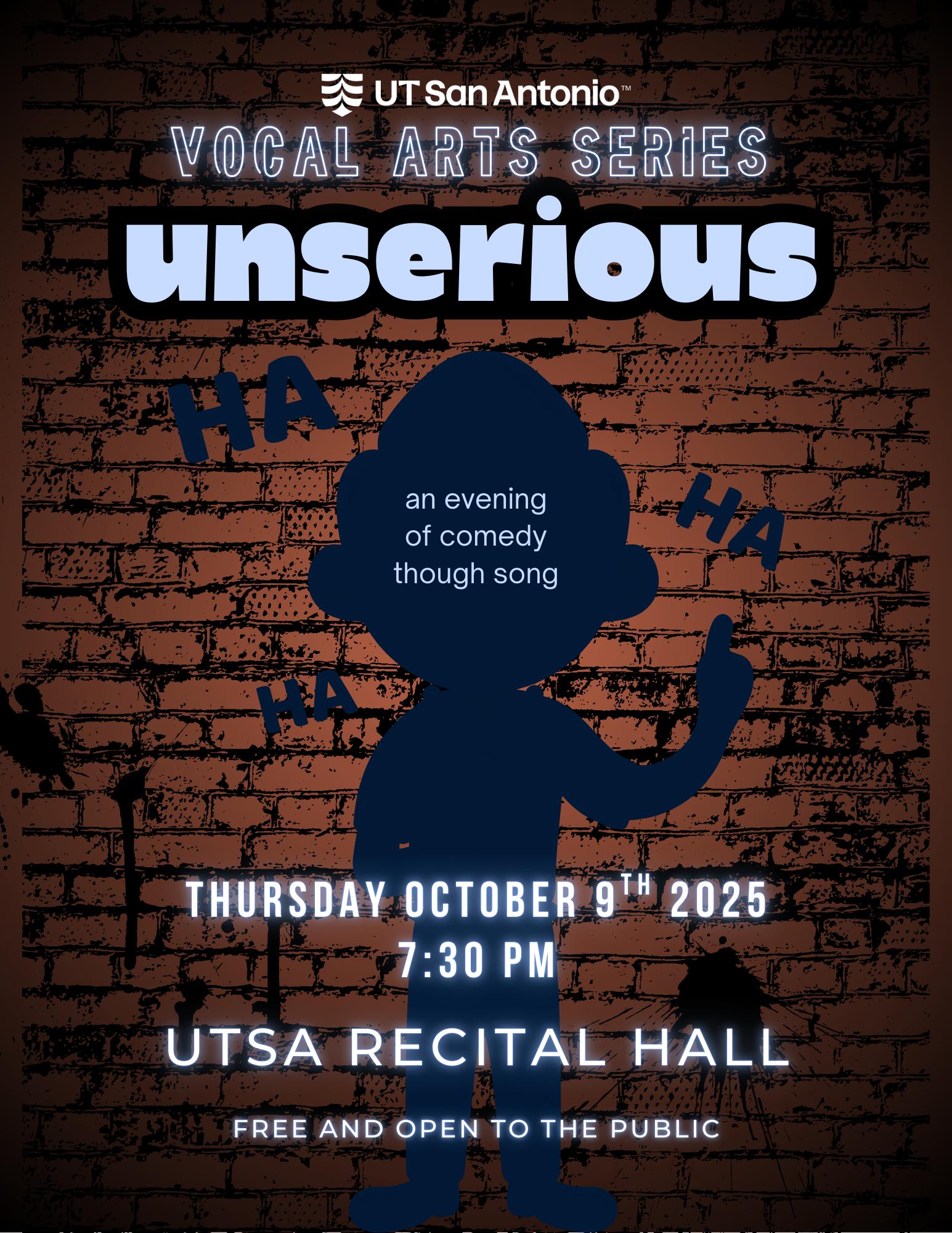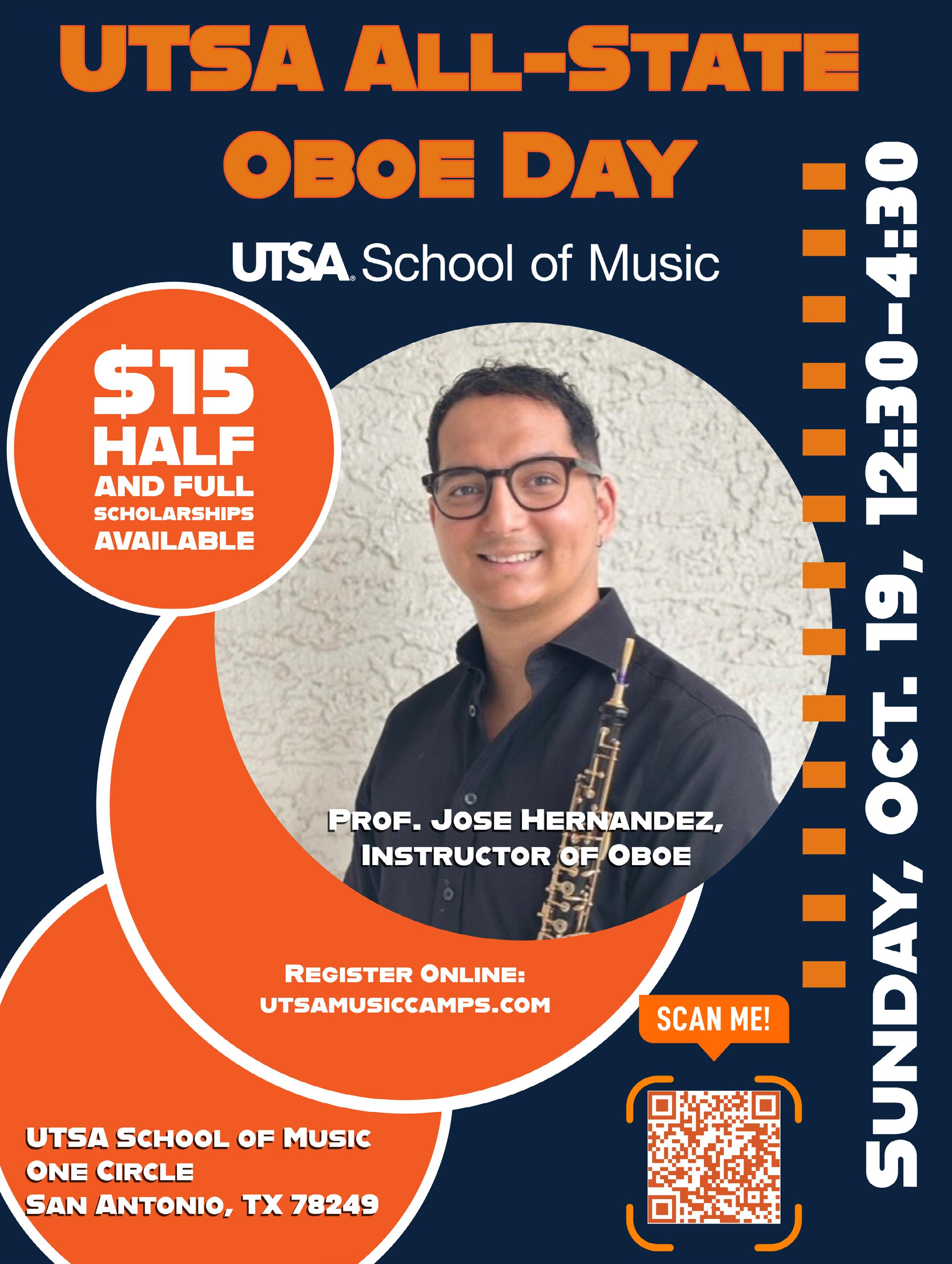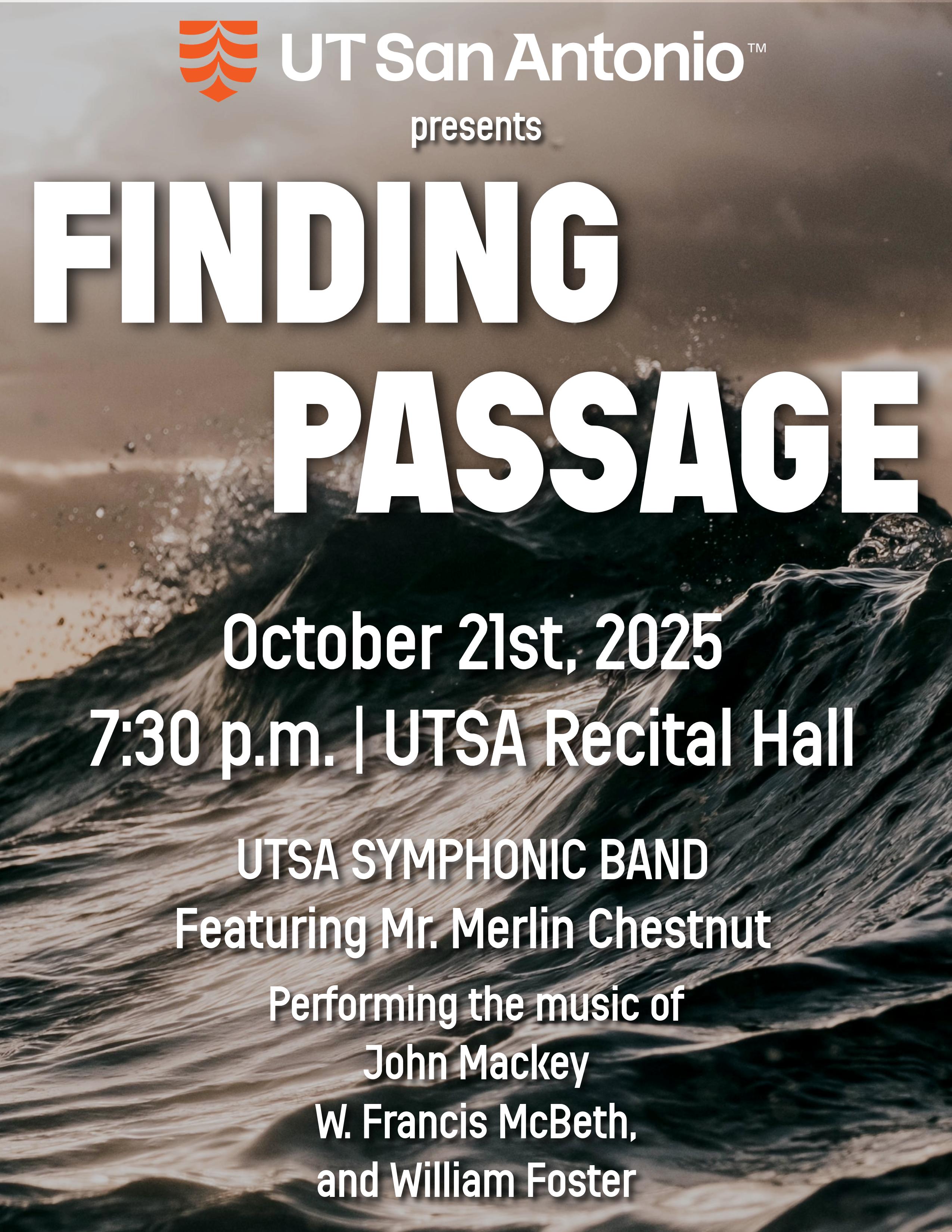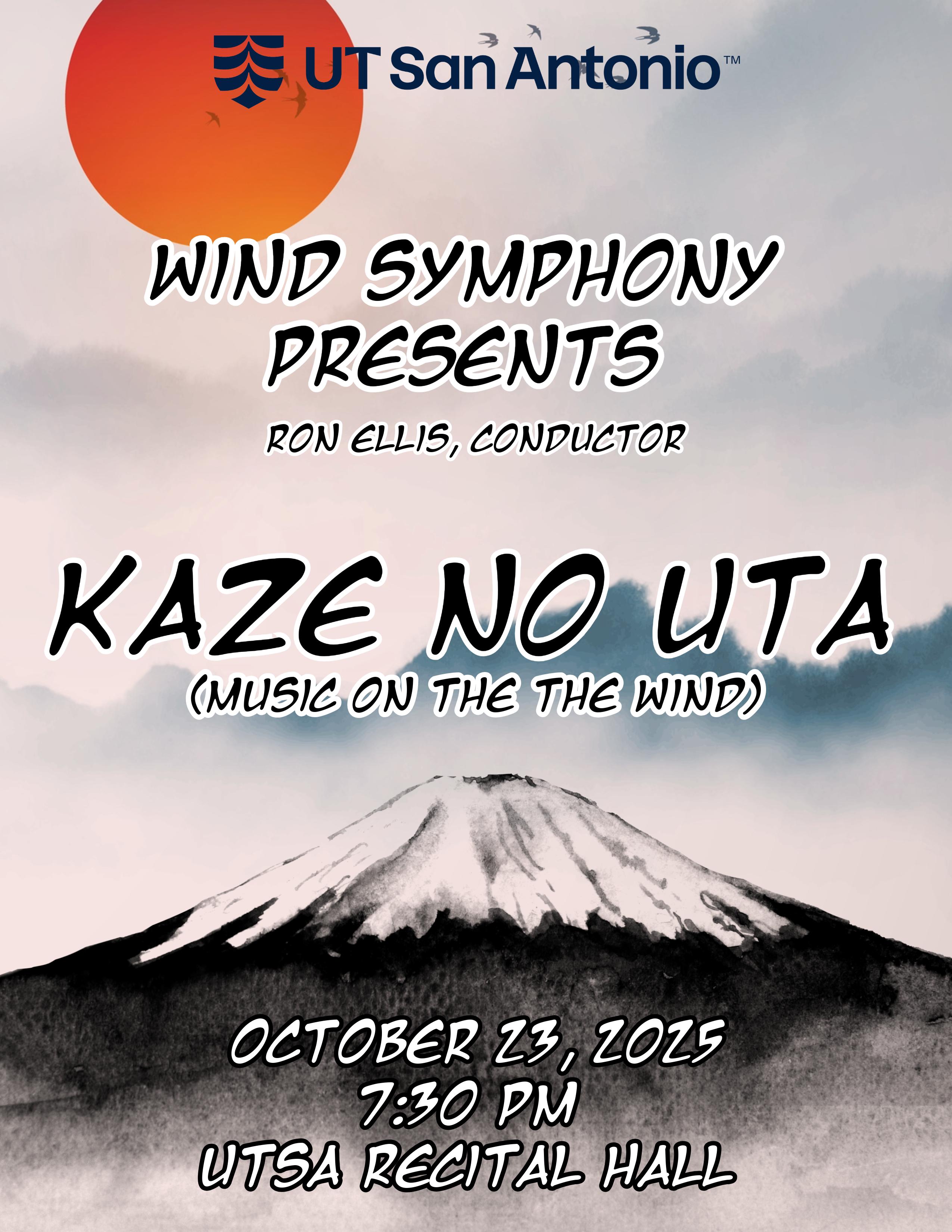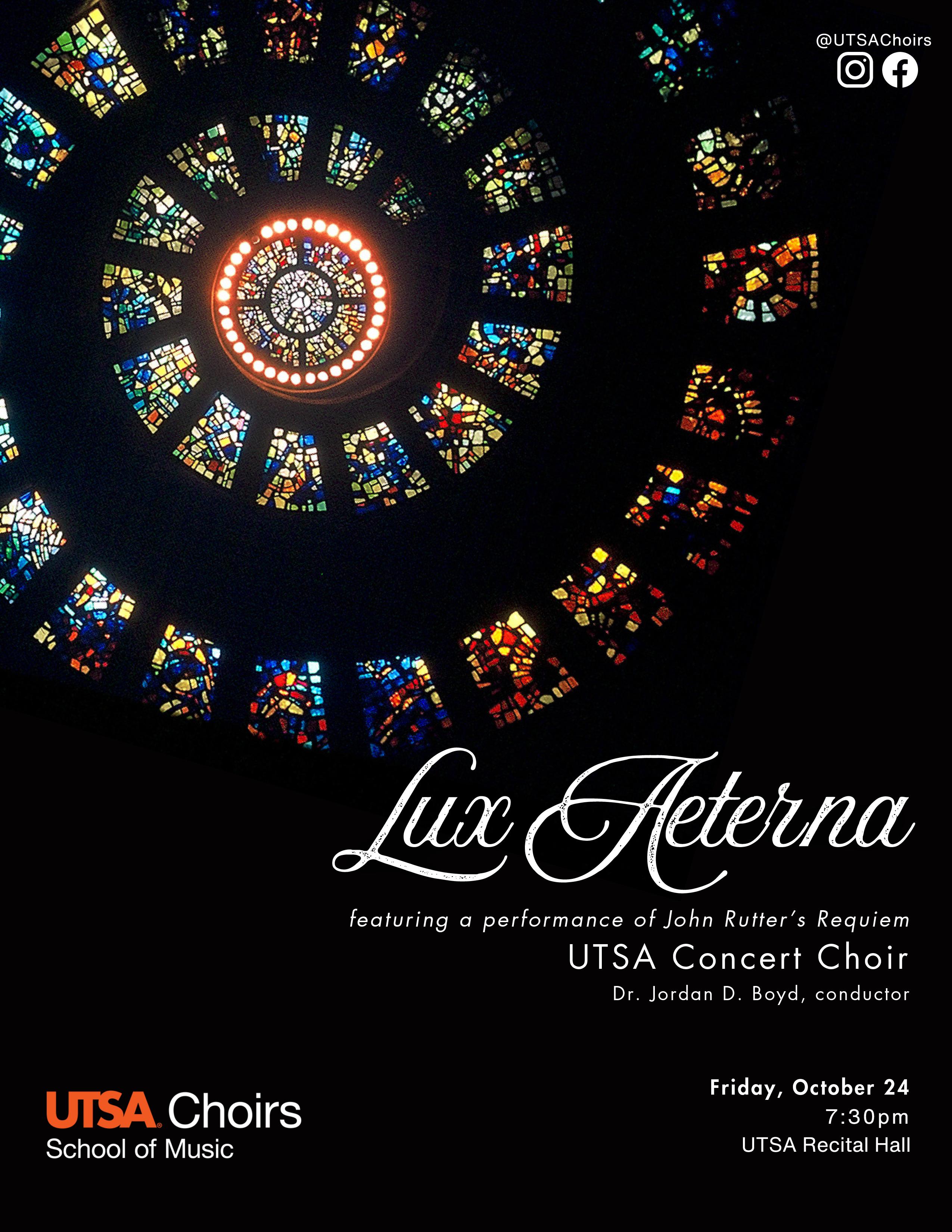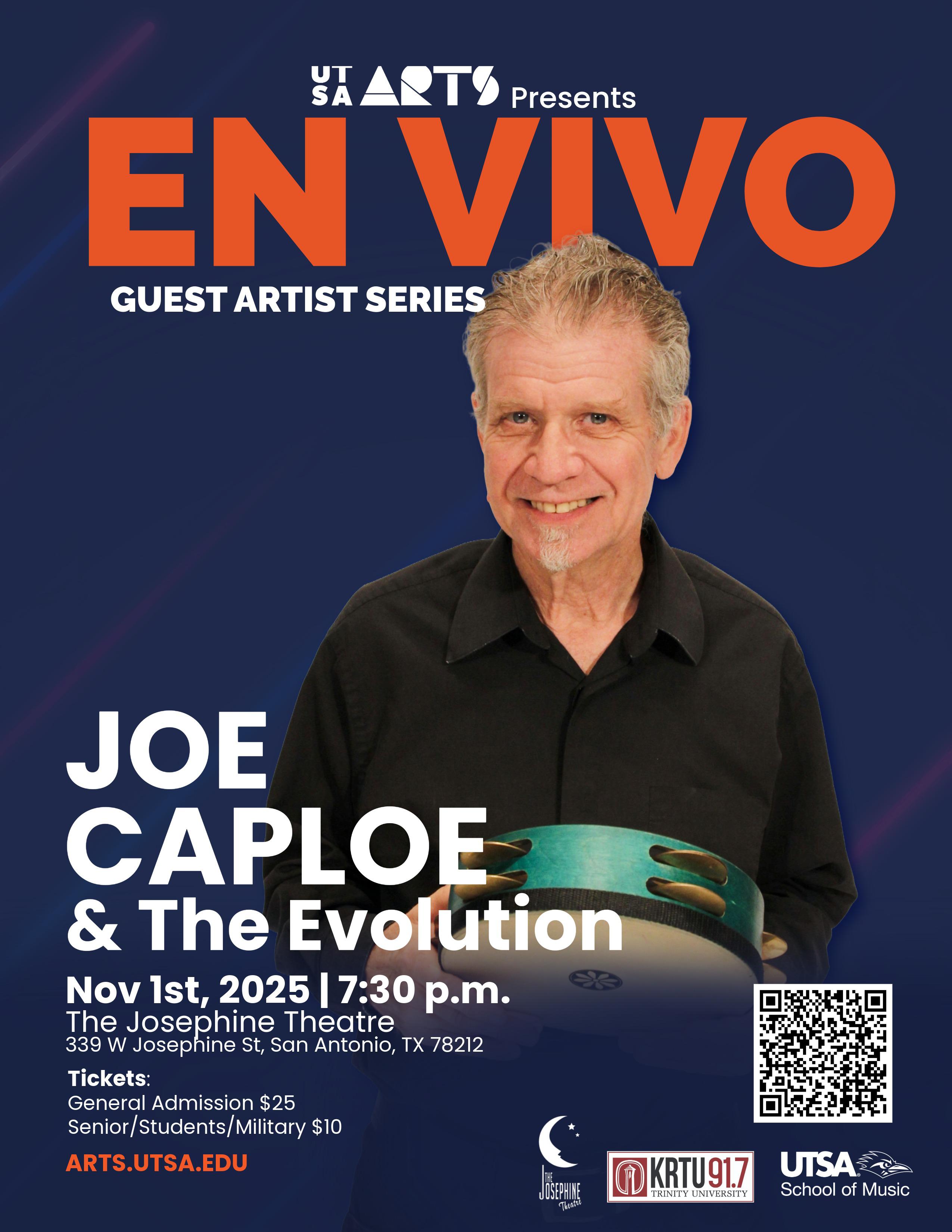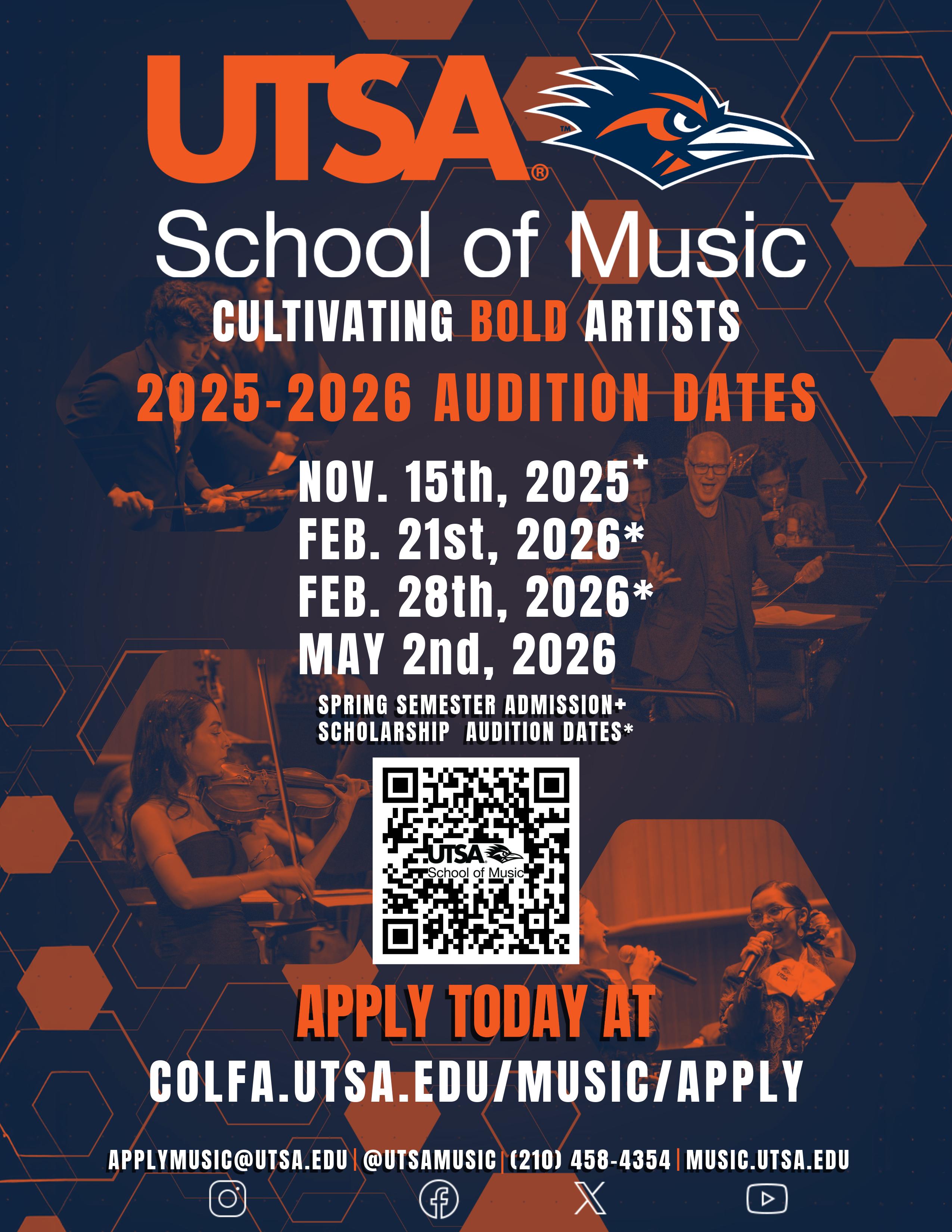Spring 2025 University of Texas at San Antonio Symphony Orchestra
Flute / Piccolo
Jazmine Dearlove
Paige De La O ^
Lauren Garcia + Brianna Martinez +
Oboe
Makayla Aguilar + Logan Odom+
Clarinets
Kenedy Lerma + Isabella Miranda +
Bassoons
Walter Jordan + Jaime Viejo +
Horns
Brandon Bayer + Noe Loera ^
Francis Maille-Romero
Andrew Ramirez ^
Trumpets
Gustavo Medrano + Daniel Vazquez
Trombones
Bradley Bolton + Jayden Zunker-Treviño + Javier Lopez, Bass
Tuba
Matthew Caleb Bruns
Perc
Gregory Felter + Adam Jackson
Juan Martinez
Rebecca Palmer
Piano
Alesia Bridgewski
Violin I
Keith Beene *
Harmony Grace * Daniel Rocha
Malachi Landin
Javier Martinez
Akemi Nunez-Martinez
Daniel Constantino
Jennivie Bui
Karyl De Guzman
Isaac Cortez
Violin I (continued)
Mailyn Armijo-Trinidad
Evelyn Escalon
Christal Martinez
Elijah Boston
Violin II
Joseph Buechner +
Josette Garcia + Kayla Strizu
Alyssa Perez
Elena Castillo
Jaylin Cahee
Alvin Philip
Jamal McLamb
Jake Garcia
Benny Elrod
Elise Flores
Cynthia Elias
Nicole Barragan
Viola
Bryan Echeveste + Joaquin Gomez + GuadaLupe Lopez
Ethen Greenberg
Abraham Abergo
Cello
Natalie Esquivel + Isaiah Valdez +
Katherine Beebe
Emily Lo
Leyton Leslie
Ethan Barrera
Valerie Hernandez
Benjamin Wood
Double Bass
Heri Ayma + Leonardo Huerta Lima
Fletcher Lowe
Damien Peters
Sebastian Ortiz
Demtric Williams
Pedro Badillo-Garcia
Staff
Eva Ayala, Music Librarian
Jared Worman, Music Librarian
Isaiah Valdez, Personnel Manager
Elena Castillo, Social Media Manager
Akemi Nunez-Martinez, Social Media Manager
Emily Lo, Stage Manager
Fletcher Lowe, Stage Manager
Javier Martinez, Stage Manager
*Denotes Concert Master/Co-Concert Master
+Denotes Principal
^Denotes Assisting Musician
Conductor
Asieh Mahyar is the Director of Orchestral Activities and Assistant Professor of Music at the University of Texas at San Antonio, where she also teaches graduate and undergraduate courses in conducting.
Previously, she served as the Director of Orchestral Studies at Pacific Lutheran University in Washington, Conductor of the Symphony Orchestra at the West Seattle Community Orchestras (WSCO), and has guest conducted orchestras across the country. Active as a clinician and adjudicator, she has collaborated with youth and high school orchestras, festivals, and conferences throughout the United States, including the 2024 Washington Music Educators Association (WMEA) Conference.
A Doctor of Musical Arts candidate (ABD) in Orchestral Conducting at Michigan State University, Mahyar holds a Master of Music in Orchestral Conducting from the University of Massachusetts Amherst and a Bachelor of Music with Honors in Choral Conducting from the Komitas State Conservatory in Yerevan, Armenia.
Guest Faculty Soloist
Dr. Sarah Wildey-Richmond is the Senior Lecturer of Bassoon, Music History and Literature at The University of Texas at San Antonio. An avid orchestral musician, Dr. Wildey holds the contrabassoon chair with the Amarillo Symphony, is the principal bassoonist of San Antonio Harmonie, and a historical bassoonist with Sonido Borroco. Originally from Upstate New York, Dr. Wildey received her DMA from The University of Iowa under the tutelage of Benjamin Coelho. She also holds degrees from Indiana University and York College of Pennsylvania. Outside of music, Dr. Wildey is passionate about animal rescue, baking and cooking, and knitting. She currently lives in San Antonio with her husband, Will, and far too many foster animals.
Follow us:
Webpage: UT San Antonio Symphony Orchestra
Instagram: @ UTSAOrchestras
Facebook: UTSAOrchestras
For More Information: Visit our
Website UTSA School of Music
UTSA School of Music Website UTSA School Of Music Socials
Special thanks to the following for their ongoing support and dedication to the UTSA Symphony Orchestra:
Dr. Tracy Cowden, Director, School of Music
Dr. Stacey Davis, Associate Director, School of Music
Dr. Kasandra Keeling, Associate Director, School of Music
Naomy Ybarra, Administrative Services Officer 1
Steven Hill, Administrative Associate
Jared Davis, Senior Events Manager
Joey Berrios, Marketing Coordinator
Rico Gomez, Music Program Specialist
Dr. John Zarco, Director of Instrumental Ensembles
Prof. Ron Ellis, Director of Bands
Prof. Hector Garcia, Assistant Director of Athletic Bands
Dr. Nicole Cherry, String Area Coordinator
Prof. Sherry Rubins and Prof. Paul Millette, Percussion Area Faculty
Dr. Rachel Woolf and Dr. Oswaldo Zapata, Woodwind and Brass Area Coordinators
Dr. Yoojin Muhn, Director of Choral Activities
Dr. Jordan Boyd, Assistant Director of Choral Activities
UTSA School of Music Faculty
Eva Ayala and Jared Worman, School of Music Librarians
UTSA Symphony Orchestra Managers
Program Notes
Danzon No. 2
Born in Mexico, Arturo Márquez spent his middle school and high school years in La Puente, California, where he began his musical training. After he returned to Mexico, Márquez studied at the Conservatory of Music and the Institute of Fine Arts in Mexico, followed by private study in Paris with Jacques Castérède, and then at the California Institute of the Arts with Morton Subotnick, Stephen Mosko, Mel Powell, and James Newton.
At that time, Márquez was much interested in avant garde techniques and processes, although his time at Cal Arts gave him ideas about how jazz and world music elements could be added to the mix. His first Danzón, composed in 1992, shows how that was beginning to play out. It was essentially an electronic piece for tape and optional saxophone, but including Minimalist aspects and references to the traditional danzón, an old salon dance from Cuba that became very popular in Veracruz and then in Mexico City, where it still holds sway.
This initial elaboration on the danzón proved crucial for Márquez, renewing his own musical language in a turn away from Modernist impulses. His Danzón No. 2, one of the most popular pieces of “classical” music of the last quarter-century, confirmed this new direction.
“The idea of writing the Danzón No. 2 originated in 1993 during a trip to Malinalco with the painter Andrés Fonseca and the dancer Irene Martínez, both of whom are experts in salon dances with a special passion for the danzón, which they were able to transmit to me from the beginning, and also during later trips to Veracruz and visits to the Colonia Salón in Mexico City,” the composer writes. “From these experiences onward, I started to learn the danzón’s rhythms, its form, its melodic outline, and to listen to the old recordings by Acerina and his Danzonera Orchestra.
I was fascinated and I started to understand that the apparent lightness of the danzón is only like a
visiting card for a type of music full of sensuality and qualitative seriousness, a genre which old Mexican people continue to dance with a touch of nostalgia and a jubilant escape towards their own emotional world; we can fortunately still see this in the embrace between music and dance that occurs in the State of Veracruz and in the dance parlors of Mexico City.”
- Program notes by John Henken and the composer, reached at La Phil
Concerto for Bassoon and String Orchestra
Commissioned by bassoonist Jacqueline Wilson, this concerto is a single-movement work for bassoon and string orchestra, running approximately 11 minutes. As a performer, educator, and advocate for new music by Native composers, Wilson brings a unique energy and perspective to this piece, which was written specifically with her remarkable talent in mind.
The concerto does not follow a specific narrative but is deeply rooted in themes of spirituality, viewed from a Native perspective that resonates universally. The opening of the work features the bassoon in a solo invocation a call to enter a realm of spiritual reflection. Throughout the piece, the bassoon acts as an individual voice, while the string orchestra embodies higher consciousness, a holy realm, or perhaps the exploration of ideas beyond human experience.
Emotionally, the piece moves through a range of moods: from uncertainty to hopefulness, and even to concepts that defy concrete interpretation. The music invites listeners to engage with it on a personal level, offering an experience that shifts depending on the listener's own reflections and perceptions.
Although this work stands alone, it is deeply inspired by the ways in which we, as humans, connect with the "holy world" whether through prayer, ritual, or offerings like corn pollen and cedar. The bassoon's melodies, in this sense, act as a spiritual invocation, connecting us with the higher realms beyond the physical world.
I hope this piece encourages audiences to approach with open hearts and minds, allowing for a unique and personal journey.
-Program notes from the composer
Symphony
No.1 in E minor
Born in Little Rock, Florence Price gave her first piano recital at age 4, published her first piece at 11, and entered the New England Conservatory at 15. There she studied piano and took composition lessons from George Whitefield Chadwick and Frederick Converse. Graduating at age 18, she taught at Shorter College in Arkansas, and in 1910 she became the head of the music department at Clark University in Atlanta. Returning to Little Rock, she married, and in 1927 the family moved to Chicago, where Florence studied composition with Leo Sowerby and wrote musical jingles for radio commercials to help support her family.
Price was a prolific composer. She wrote more than 300 works, including four symphonies, two violin concertos, a piano concerto, piano music, and a large number of songs and choral compositions. Most of these remain unpublished, and while some of her works have been recorded, Price’s music is only now being discovered by audiences.
Price composed her Symphony No. 1 in E Minor in 1931-32 while recovering from a broken foot. That misfortune turned out to be a blessing in disguise, because it gave her time to work. To a friend she
wrote: “I found it possible to snatch a few precious days in the month of January in which to write undisturbed. But, oh dear me, when shall I ever be so fortunate again as to break a foot!” Submitted to the Rodman Wanamaker Competition, her First Symphony promptly won first place and was premiered at the Chicago World’s Fair on June 15, 1933 by the Frederick Stock and the Chicago Symphony Orchestra. It was the first work by an African-American woman to be performed by a major American symphony orchestra.
Chadwick and Converse were themselves conservative composers, and they had trained Price in the forms and methods of late 19th-century European music―one often hears echoes of Dvořák and Brahms in her music. But they also encouraged Price to make use of the music of her AfricanAmerican heritage, and that combination of influences gives her music some of its distinctive character.
Price’s First Symphony begins with two long movements and concludes with two short ones. The opening Allegro non troppo is in sonata form and is based on two theme groups―all listeners sense the influence of Dvořák on the second theme here. The slow movement opens with a lovely brass chorale (Price’s marking is here Maestoso: “Majestic”), and this chorale goes through a number of lovely extensions, sometimes accompanied by drums and bells. The third movement is in the form of a juba dance, one of Price’s favorite dance forms. Originally brought to the United States by slaves from West Africa, the juba was built on syncopated rhythms and the sound of slapped drums and stomped feet. Price builds this concise movement up to an exciting climax, and it comes to a grand conclusion. The symphony concludes with a brief but lively Presto. -
-Program notes by Eric Bromberger, reached at The Santa Fe Symphony



